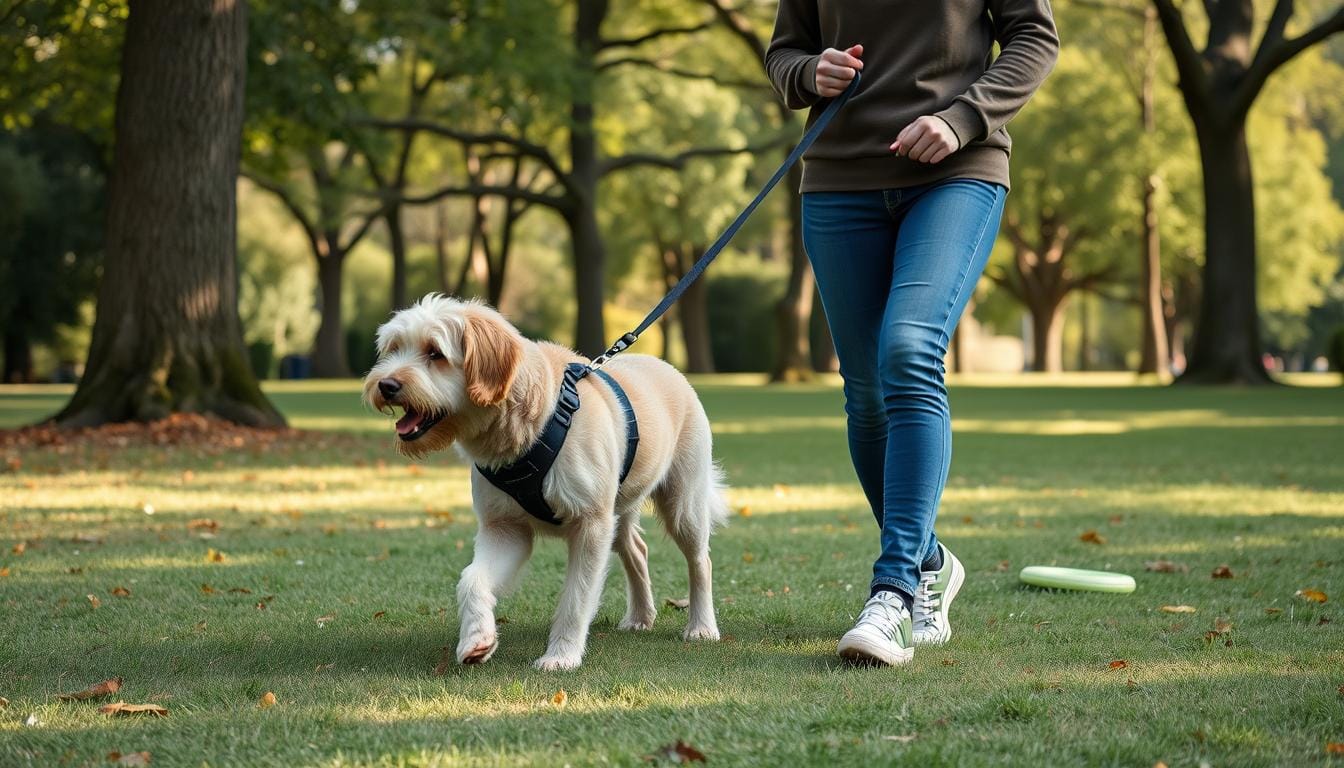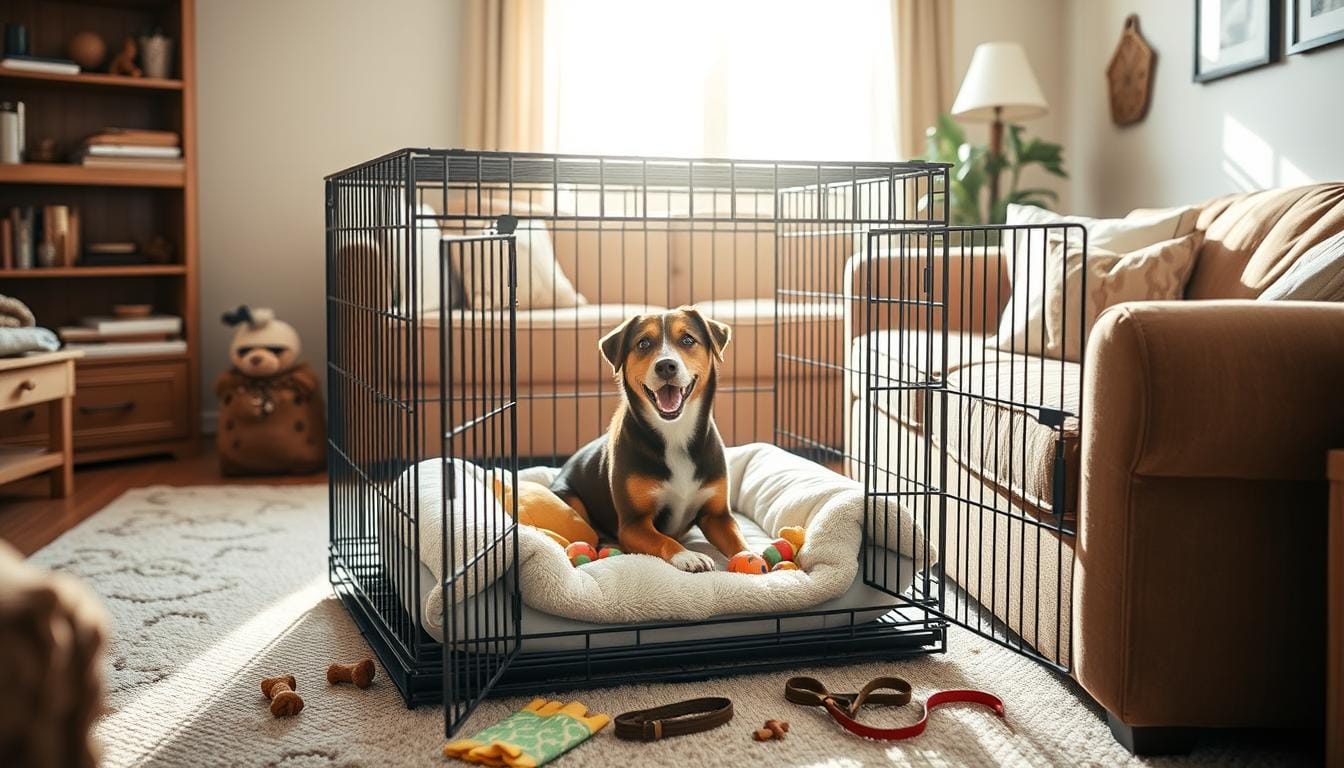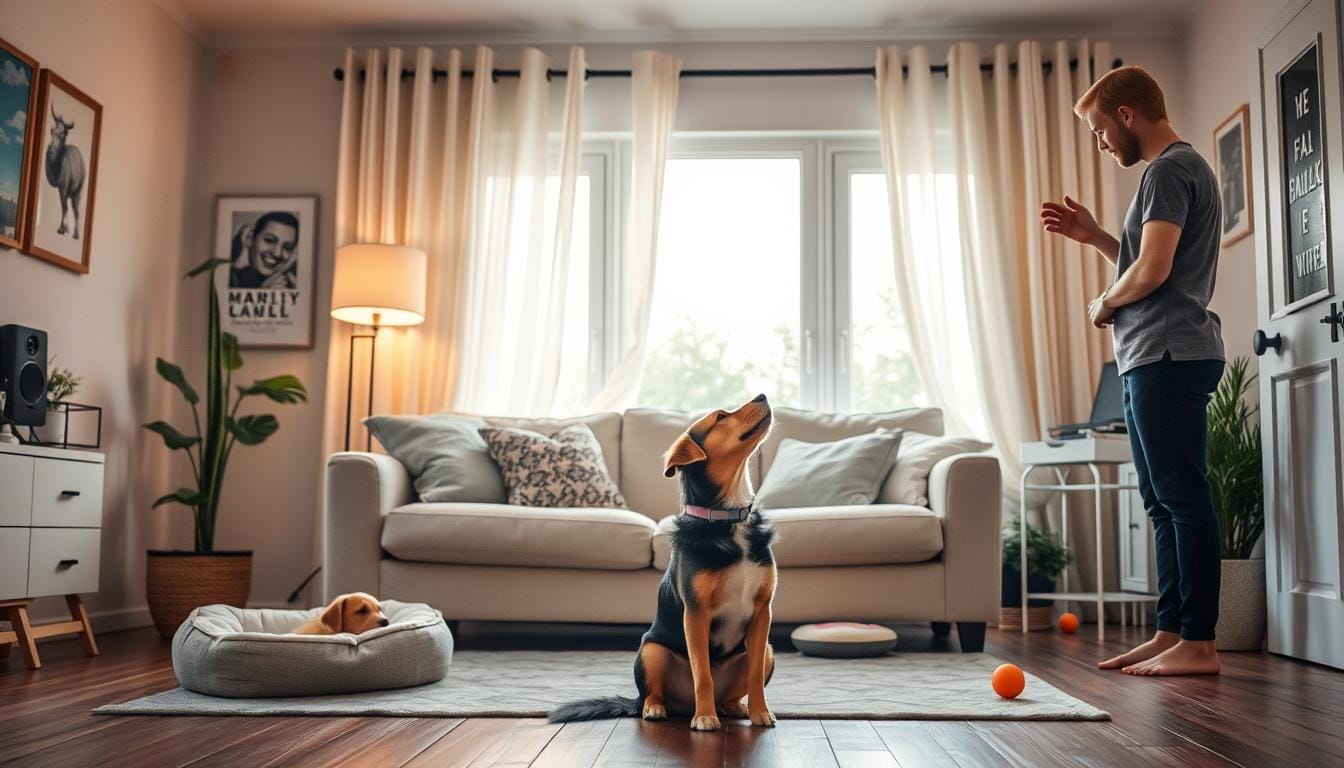Dogs can sense human emotions instinctively. They can pick up on our body language and vocal tones. This lets them communicate with us in special ways, like through barking.
Barking is natural for dogs, but too much can be a problem. In this article, we’ll look at ways to stop dog barking and improve their behavior. We’ll cover the reasons behind barking, training techniques, and solutions to help you have peace at home.
We aim to give you practical strategies for a better relationship with your dog. By understanding why they bark and using effective training, you can manage their barking.
Key Takeaways
- Understand the reasons behind your dog’s barking
- Learn positive reinforcement techniques for training
- Discover the importance of exercise in reducing barking
- Explore environmental management strategies
- Find out how socialization impacts barking behavior
- Learn about mental stimulation tools to keep your dog engaged
- Understand the role of consistency in successful training
Understanding Why Dogs Bark
Dogs bark for many reasons. Knowing these can help us meet their needs better. Barking is a way dogs communicate and serves different purposes.
Common reasons for barking
Dogs bark for several reasons. They might bark to protect their territory, alert others, or show excitement. Some breeds, like Siberian Huskies, have unique sounds like howling.
Beagles, for example, bark to follow a scent trail. This is known as “bay.”
Identifying your dog’s specific triggers
To stop barking, we must find out what causes it. Common reasons include:
- Passersby or other dogs
- Unfamiliar sounds
- Separation anxiety
- Lack of exercise or mental stimulation
The importance of addressing underlying causes
It’s key to tackle the real reasons for barking. For example, if boredom causes it, more playtime can help. If it’s due to separation anxiety, slow steps to get used to being alone might be needed.
| Bark Type | Description | Possible Cause |
|---|---|---|
| Rapid with pauses | Alarm bark | Alerting to situation |
| High-pitched | Greeting bark | Recognition of familiar person |
| Deep continuous | Rumble growl | Asking for space |
Understanding dog behavior and barking can help us communicate better. This leads to a better relationship with our dogs.
The Role of Exercise in Reducing Barking
Exercise is key to stopping too much barking. A dog that gets enough exercise barks less. It helps them burn energy and stay happy and healthy.
Physical activity helps manage barking. Daily walks, runs, or playtime can cut down on barking. High-energy dogs need more intense activities to use up their energy.

Mental stimulation is also vital. Activities that challenge your dog’s mind can stop boredom barking. Puzzle toys, obedience training, and scent work are great for keeping their mind busy.
Combining physical and mental exercises works best. This mix makes your dog happier and calmer. Using a pet activity tracker helps ensure they get enough exercise to stop barking.
“Regular engagement in mental stimulation activities can dramatically reduce instances of boredom-induced barking.”
Here’s a list of exercises and their benefits:
| Exercise Type | Benefits | Frequency |
|---|---|---|
| Walks | Builds bond, reduces anxiety, exposes to outdoor stimuli | Twice daily |
| Light Runs/Jogging | Safe energy outlet, fun activity | 3-4 times weekly |
| Interactive Play | Engages dog, satisfies adventure craving | Daily |
| Beach Trips | New environment, sensory stimulation | Weekly (if possible) |
Consistency is crucial. It might take a week of regular exercise to see a change in barking. Be patient and keep up the good work to keep your dog happy and healthy.
Training Your Dog to “Speak” and “Quiet”
Dog training is about teaching obedience commands to stop unwanted behaviors. We’ll show you how to teach your dog the “Speak” and “Quiet” commands. We’ll use positive reinforcement techniques.
Teaching the “Speak” Command
Begin by getting your dog to bark. Use something like a doorbell or knock on the door. When they bark, say “Speak” and give them a treat.
Keep doing this, adding the command before they bark. Some dogs learn fast, while others need a week of practice.
Introducing the “Quiet” Command
When your dog can “Speak” on command, it’s time for “Quiet.” Wait for a pause in their barking, then say “Quiet” and give a treat.
Slowly increase how long they need to be quiet before rewarding. Use simple words like “hush” or “enough” for consistency.
Positive Reinforcement Techniques
Positive reinforcement is essential in dog training. Use treats like liver or chicken pieces. Keep training sessions short, about 10-15 minutes, several times a day.
A clicker can help mark good behavior. Practice in different places to help them learn in various environments.
“Patience and consistency are crucial. It may take weeks for some dogs to master these commands, but the results are worth it.”
Remember, well-trained dogs learn these commands faster. Over time, you can stop using treats to keep the behavior going. With patience and practice, you’ll have better control over your dog’s barking.
How to Stop Dog from Barking: Desensitization Techniques
Desensitization is a key method in dog training techniques. It helps cut down on too much barking. You do this by slowly introducing your dog to things that make them bark, but in a way that’s positive.
To begin, figure out what makes your dog bark. It might be people walking by or someone knocking on the door. Once you know, start by showing your dog these things at a very low level.

For instance, if your dog barks at people outside, start by giving them treats when they’re far away. Then, slowly move closer as they get used to it. This takes time and patience, but it can really help.
“Preventing barking problems is easier than correcting them through early socialization and positive reinforcement training.”
Here’s how to do desensitization step by step:
- Find out what makes your dog bark
- Show them the trigger at a low level
- Give them treats for staying calm
- Keep moving closer to the trigger
- Do this every day
Desensitization works best with other training methods too. Things like more exercise and fun puzzle toys can help a lot.
| Barking Cause | Desensitization Approach |
|---|---|
| Fear/Alert | Gradual exposure to triggers, reward calm behavior |
| Boredom | Increase mental stimulation, provide interactive toys |
| Attention-seeking | Ignore barking, reward quiet behavior |
If these steps don’t work, talk to a professional dog trainer. They can make a plan just for your dog.
Managing Your Dog’s Environment
Effective dog environment management is key to less barking. Simple changes in your dog’s space can make it calmer. This helps your dog feel more at ease and less stressed.
Removing Visual Stimuli
Dogs bark at things they see outside. To stop this, block their view. Close curtains or blinds, or use window film. This can greatly cut down on barking at things they see.
Using White Noise or Music
White noise machines or soft music can calm your dog. They create a peaceful sound that blocks out loud noises. This helps reduce stress and barking caused by outside sounds.
Creating a “Safety Zone” for Your Dog
Make a quiet spot in your home for your dog. It could be a crate or a cozy corner. Add their favorite toys and blankets. This safe space helps your dog feel secure and less likely to bark.
“A well-managed environment can significantly reduce a dog’s stress levels and minimize excessive barking.”
Every dog is different. Try these ideas to see what works for your dog. With patience and consistency, you can make a peaceful home for both you and your dog.
Using Anti-Stress Devices and Accessories
Excessive barking can be a sign of anxiety in dogs. We can help our furry friends with anti-stress devices and calming aids. These tools are great for anxiety relief and can cut down on unwanted barking.
Pheromone-based collars and diffusers are popular choices. They mimic the calming scents mother dogs produce, creating a soothing environment. Another effective option is anxiety wraps or jackets. These provide gentle pressure, similar to swaddling a baby, which can help calm nervous dogs.
For dogs with separation anxiety, weighted clothes can offer comfort. Calming chews and sprays are also available, providing a natural way to reduce stress. In severe cases, veterinarians might prescribe medication to help manage anxiety-related barking.
- Pheromone collars and diffusers
- Anxiety wraps and jackets
- Weighted clothes
- Calming chews and sprays
- Prescription medication (in severe cases)
It’s important to note that these anti-stress devices work best when combined with proper training and environmental management. They’re not a magic solution but can be a valuable part of a comprehensive approach to reducing anxiety-related barking in our canine companions.
“Anti-stress devices can be particularly useful for dogs that bark due to stress or separation anxiety. While not a standalone solution, they can complement other training techniques effectively.”
Socialization: A Key to Reducing Reactive Barking
Proper dog socialization is key to stopping reactive barking. Early puppy training with positive experiences shapes their behavior. Let’s look at why socialization is important and how to introduce your dog to new things.
Importance of Early Socialization
The critical period for puppy socialization is between 3 and 14 weeks. Exposing puppies to various people, animals, and places helps prevent reactive behaviors. Dogs that miss these experiences are more likely to bark a lot due to fear.
Introducing Your Dog to Various Stimuli
Well-socialized puppies meet many stimuli, like different people and animals. This builds confidence and lowers fear-based reactions. For adult dogs, slow and controlled socialization can also help reduce barking.
Positive Experiences with People and Other Dogs
Positive associations during socialization are crucial. Use treats and praise for calm behavior around new things. When meeting other dogs, keep them calm to avoid bad reactions. Remember, yelling or punishing can make things worse.
| Socialization Stage | Focus Areas | Benefits |
|---|---|---|
| Early Puppy (3-14 weeks) | People, dogs, environments, sounds | Reduced fear, better adaptability |
| Adolescent (3-6 months) | Reinforcing early experiences | Improved social skills, confidence |
| Adult (6+ months) | Gradual exposure, positive reinforcement | Decreased reactivity, calmer behavior |
By focusing on proper socialization and positive experiences, we can help our dogs become well-adjusted companions. This reduces the chance of reactive barking and other issues.
Mental Stimulation: Puzzles and Interactive Toys
Many of us forget how important mental games are for our dogs. Dog puzzles and interactive toys are great for keeping them busy and sharp. These toys do more than just entertain; they help reduce barking by fighting boredom and anxiety.
There are many types of interactive toys, like Kongs that dispense treats and puzzle feeders. The Nina Ottosson Dog Brick, for instance, makes dogs work to find treats. Snuffle mats, such as the Paw5 Wooly Snuffle Mat, offer a fun way for dogs to find kibble or treats.
Adding these activities to your dog’s daily life does more than stop barking. It also boosts their brain power, which is key for smart dogs. Make sure to switch toys often to keep things fresh and exciting. With a mix of physical play and brain games, our dogs can live happier, quieter lives.









